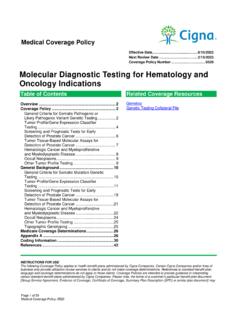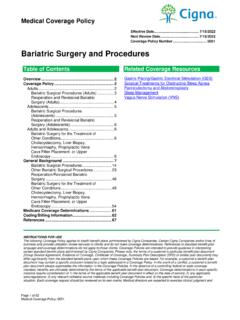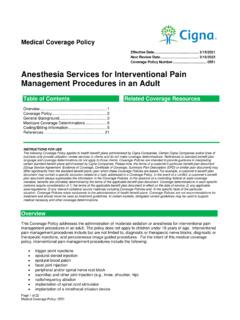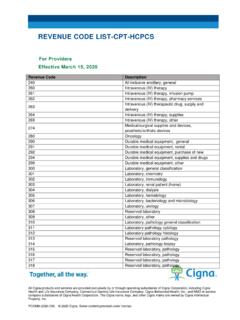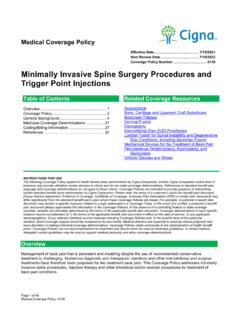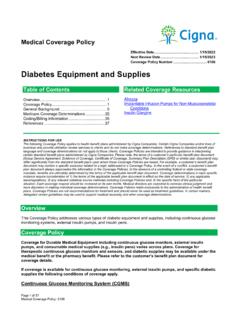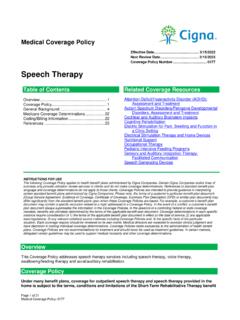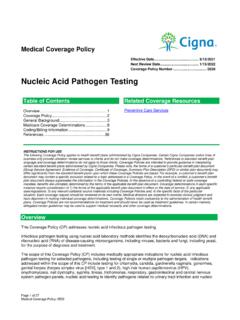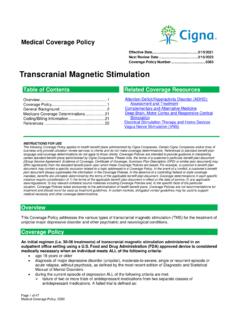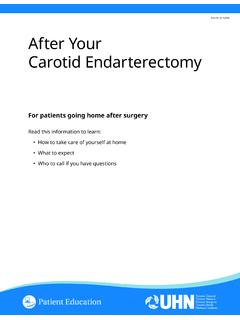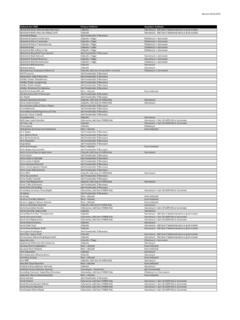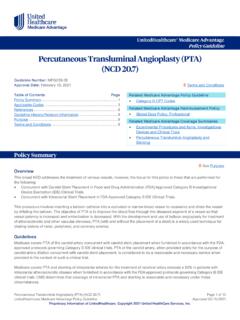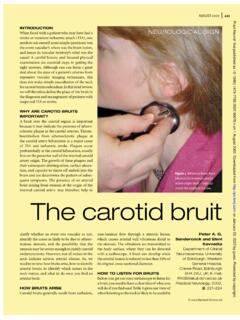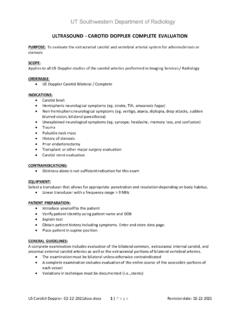Transcription of Duplex Scan for Carotid Artery Stenosis
1 Page 1 of 24 Medical Coverage Policy: 0542 Medical Coverage Policy Effective Date .. 7/15/2021 Next Review Date .. 7/15/2022 Coverage Policy Number .. 0542 Duplex Scan to Evaluate for Carotid Artery Stenosis Table of Contents Overview .. 1 Coverage Policy .. 1 General Background .. 2 Medicare Coverage Determinations .. 4 Coding/Billing Information .. 5 References .. 23 Related Coverage Resources Carotid Intima-Media Thickness Measurement INSTRUCTIONS FOR USE The following Coverage Policy applies to health benefit plans administered by Cigna Companies. Certain Cigna Companies and/or lines of business only provide utilization review services to clients and do not make coverage determinations. References to standard benefit plan language and coverage determinations do not apply to those clients. Coverage Policies are intended to provide guidance in interpreting certain standard benefit plans administered by Cigna Companies. Please note, the terms of a customer s particular benefit plan document [Group Service Agreement, Evidence of Coverage, Certificate of Coverage, Summary Plan Description (SPD) or similar plan document] may differ significantly from the standard benefit plans upon which these Coverage Policies are based.
2 For example, a customer s benefit plan document may contain a specific exclusion related to a topic addressed in a Coverage Policy. In the event of a conflict, a customer s benefit plan document always supersedes the information in the Coverage Policies. In the absence of a controlling federal or state coverage mandate, benefits are ultimately determined by the terms of the applicable benefit plan document. Coverage determinations in each specific instance require consideration of 1) the terms of the applicable benefit plan document in effect on the date of service; 2) any applicable laws/regulations; 3) any relevant collateral source materials including Coverage Policies and; 4) the specific facts of the particular situation. Each coverage request should be reviewed on its own merits. Medical directors are expected to exercise clinical judgment and have discretion in making individual coverage determinations. Coverage Policies relate exclusively to the administration of health benefit plans.
3 Coverage Policies are not recommendations for treatment and should never be used as treatment guidelines. In certain markets, delegated vendor guidelines may be used to support medical necessity and other coverage determinations. Overview This Coverage Policy addresses the use of Duplex scan to evaluate for Carotid Artery Stenosis . Duplex scanning is a type of ultrasound that evaluates the Carotid Artery for interruptions in blood flow. Coverage Policy Duplex scan to evaluate for Carotid Artery Stenosis is considered medically necessary for ANY of the following indications: disorders of the Carotid Artery new or worsening neurologic symptoms, including stroke ( , cerebrovascular attack [CVA]), transient ischemic attack (TIA), amaurosis fugax unilateral motor or sensory deficit, and speech impairment altered level of consciousness dementia seizures Carotid bruit Page 2 of 24 Medical Coverage Policy: 0542 preoperative evaluation for cardiovascular or Carotid surgical procedures evaluation of the Carotid arteries in an individual with a history of Carotid disease suspected Carotid Artery dissection, fistula, or pseudoaneurysm malignancy of the Carotid body migraine headache retinal vein or Artery occlusion and hemorrhage myocardial infarction coronary Artery disease atrial fibrillation and atrial flutter intracranial infarction and hemorrhage dissection of the Carotid and thoracic Artery Screening for Carotid Artery Stenosis by Duplex scan in an asymptomatic individual is considered not medically necessary.
4 General Background Duplex ultrasound modalities combine 2-dimensional real-time imaging with Doppler flow analysis to evaluate vessels of interest (typically the cervical portions of the common, internal, and external Carotid arteries) and measure blood flow velocity. The method does not directly measure the diameter of the Artery or stenotic lesion. Instead, blood flow velocity is used as an indicator of the severity of Stenosis . Although results vary greatly between laboratories and operators, the sensitivity and specificity for detection or exclusion of >70% Stenosis of the internal Carotid Artery are 85% to 90% compared with conventional angiography (Brott, 2011). The Coverage Criteria in this Medical Coverage Policy are primarily based on recommendations from published practice parameters, recommendations and professional society/organization consensus guidelines. Duplex scanning of the Carotid arteries to evaluate for Stenosis is recommended when an individual has symptoms that may suggest blockage.
5 Screening for Carotid Artery Stenosis by Duplex scan is not clinically useful for an individual without symptoms indicating a possible blockage Professional Societies/Organizations Preventive Services Task Force (USPSTF) The USPSTF Final Recommendation Statement on Screening for Asymptomatic Carotid Artery Stenosis (February 02, 2021) states: Asymptomatic adults The USPSTF recommends against screening for asymptomatic Carotid Artery Stenosis in the general adult population. See the Practice Considerations section for a description of adults at increased risk. Grade: D The USPSTF recommends against the service. There is moderate or high certainty that the service has no net benefit or that the harms outweigh the benefits. Discourage the use of this service. This recommendation is consistent with the 2014 USPSTF recommendation. This is not a change. This recommendation applies to adults without a history of transient ischemic attack, stroke, or other neurologic signs or symptoms referable to the Carotid arteries.
6 American Heart Association/American Stroke Association (AHA/ASA) The AHA/ASA Guidelines for the primary prevention of stroke (Meschia, et al., 2014) recommend: Screening low-risk populations for asymptomatic Carotid Artery Stenosis is not recommendeds (*Class III; Level of Evidence C). Page 3 of 24 Medical Coverage Policy: 0542 It is reasonable to repeat Duplex ultrasonography annually by a qualified technologist in a certified laboratory to assess the progression or regression of disease and response to therapeutic interventions in patients with atherosclerotic Stenosis >50% (Class IIa; Level of Evidence C). American College of Cardiology Foundation (ACCF) The ASA/ACCF/ASA and numerous other organizations published joint consensus guidelines regarding the management of extracranial Carotid and vertebral Artery disease (Brott, et al., 2011): In asymptomatic patients with known or suspected Carotid Stenosis , Duplex ultrasonography, performed by a qualified technologist in a certified laboratory, is recommended as the initial diagnostic test to detect hemodynamically significant Carotid Stenosis .
7 (*Class I, Level of Evidence: C) It is reasonable to perform Duplex ultrasonography to detect hemodynamically significant Carotid Stenosis in asymptomatic patients with Carotid bruit. (Class IIA, Level of Evidence: C) It is reasonable to repeat Duplex ultrasonography annually by a qualified technologist in a certified laboratory to assess the progression or regression of disease and response to therapeutic interventions in patients with atherosclerosis who have had Stenosis greater than 50% detected previously. Once stability has been established over an extended period or the patient s candidacy for further intervention has changed, longer intervals or termination of surveillance may be appropriate. (Class IIA, Level of Evidence: C) Duplex ultrasonography to detect hemodynamically significant Carotid Stenosis may be considered in asymptomatic patients with symptomatic PAD, coronary Artery disease (CAD), or atherosclerotic aortic aneurysm, but because such patients already have an indication for medical therapy to prevent ischemic symptoms, it is unclear whether establishing the additional diagnosis of ECVD in those without Carotid bruit would justify actions that affect clinical outcomes.
8 (Class IIb, Level of Evidence: C) Duplex ultrasonography might be considered to detect Carotid Stenosis in asymptomatic patients without clinical evidence of atherosclerosis who have 2 or more of the following risk factors: hypertension, hyperlipidemia, tobacco smoking, a family history in a first-degree relative of atherosclerosis manifested before age 60 years, or a family history of ischemic stroke. However, it is unclear whether establishing a diagnosis of ECVD would justify actions that affect clinical outcomes. (Class IIb, Level of Evidence: C) Carotid Duplex ultrasonography is not recommended for routine screening of asymptomatic patients who have no clinical manifestations of or risk factors for atherosclerosis. (Class III, Level of Evidence: C) Carotid Duplex ultrasonography is not recommended for routine evaluation of patients with neurological or psychiatric disorders unrelated to focal cerebral ischemia, such as brain tumors, familial or degenerative cerebral or motor neuron disorders, infectious and inflammatory conditions affecting the brain, psychiatric disorders, or epilepsy.
9 (Class III, Level of Evidence: C) Routine serial imaging of the extracranial Carotid arteries is not recommended for patients who have no risk factors for development of atherosclerotic Carotid disease and no disease evident on initial vascular testing. (Class III, Level of Evidence: C) Duplex ultrasonography is recommended to detect Carotid Stenosis in patients who develop focal neurological symptoms corresponding to the territory supplied by the left or right internal Carotid Artery . (Class I, Level of Evidence: C) Duplex Carotid ultrasonography might be considered for patients with nonspecific neurological symptoms when cerebral ischemia is a plausible cause. (Class IIB, Level of Evidence: C) *Key: Class I = Procedure should be performed. Class IIa = It is reasonable to perform procedure Class IIb = Procedure may be considered. Class III = No benefit. Level of Evidence: C: Very limited populations evaluated. Only consensus opinion of experts, case studies, or standard of care.
10 The ACCF/American College of Radiology (ACR) and numerous other organizations published Appropriate Use Criteria for Peripheral Vascular Ultrasound and Physiological Testing. Regarding use of Carotid Duplex screening ultrasound in an asymptomatic individual the guideline notes that the test is inappropriate for an individual with a low Framingham risk score with no prior risk assessment imaging study or a low or intermediate Framingham risk score with normal prior risk assessment imaging study. Society for Vascular Surgery Page 4 of 24 Medical Coverage Policy: 0542 The Society for Vascular Surgery guidelines for Management of Extracranial Carotid Disease (Ricotta, et al., 2011) states: Screening for asymptomatic Carotid Stenosis in the general population is not indicated. American Institute of Ultrasound in Medicine (AIUM) The AIUM and Association for Medical Ultrasound published a Practice Parameter regarding extracranial cerebrovascular ultrasound which notes that the following are indications for an ultrasound examination of the Carotid and vertebral arteries.
